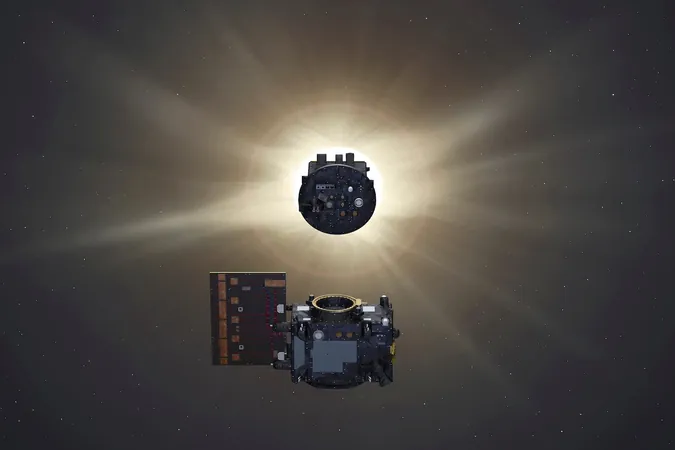
Get Ready for Proba-3: The Mission That Will Create Artificial Solar Eclipses!
2024-12-02
Author: Liam
In a groundbreaking endeavor to explore the mysteries of the Sun, the European Space Agency (ESA) is set to launch its innovative Proba-3 mission on Wednesday at 5:38 a.m. ET. This pioneering project aims to recreate the awe-inspiring phenomenon of a solar eclipse, offering scientists a unique opportunity to study the Sun's outer atmosphere—the corona—more frequently and effectively than ever before.
Every 18 months, a total solar eclipse occurs when the Moon perfectly aligns between Earth and the Sun, obscuring the star’s face for mere moments. During this rare event, scientists can examine the corona, which is usually veiled by the Sun’s glare. Proba-3 will leverage the principle of formation flying, using two satellites working in tandem to simulate this extraordinary occurrence.
Scheduled for liftoff from the Satish Dhawan Space Centre in Sriharikota, India, Proba-3 will ride aboard the Indian Space Research Organization’s (ISRO) PSLV-XL rocket. The launch will be streamed live on ESA Web TV, starting approximately 30 minutes before takeoff.
A Revolutionary Approach to Space Exploration
What’s truly remarkable about Proba-3 is its utilization of two satellites that will separate just 18 minutes after launch to engage in highly precise formation flying. Operating at a distance of 492 feet (150 meters) apart, these satellites must maintain their positions with an astounding accuracy of a single millimeter. This feat is essential for the secondary satellite to effectively block sunlight, allowing the other satellite to capture images of the corona.
“Proba-3 is very different because our satellites will be flying just one and a half football fields away from each other during active formation flying,” remarked Damien Galano, the Proba-3 mission manager. The satellites will orbit Earth at a height of roughly 37,282 miles (60,000 kilometers), reducing the gravitational effects and enabling fuel-efficient maneuvering.
During their journey, Proba-3 satellites will take about 19 hours and 36 minutes to orbit Earth, dedicating a six-hour window in each pass to gather essential data on the solar corona. While the mission could have been ideally placed at one of the Sun-Earth Lagrange points, the project's budget constraints directed the team toward an elliptical orbit that alternates between 372 miles (600 kilometers) and the far reaches of its orbit.
Unlocking the Mysteries of the Solar Corona
The solar corona remains one of the Sun's biggest enigmas. At temperatures reaching nearly 2 million degrees Fahrenheit (1 million degrees Celsius)—around 200 times hotter than the Sun's surface—scientists are baffled by how this outer layer is heated. Understanding the corona is critical, not only for unraveling the Sun's secrets but also for predicting space weather events like solar wind and coronal mass ejections that can disrupt satellite operations and communication systems on Earth.
The Proba Legacy
The Proba missions—originating from a Latin term meaning "let’s try"—aim to test new technologies in space. To date, ESA has successfully launched three other Proba missions since the inaugural Proba-1 in 2001. Proba-2, which launched in 2009, continues to gather data long past its expected life span, reflecting the durability and success of these missions.
Similar to its predecessors, Proba-3 has a planned operational life of two years, focused primarily on its limited propellant to sustain the essential maneuvers necessary for its groundbreaking observations.
As we stand on the brink of this extraordinary mission, excitement is palpable in the scientific community. "When I first heard about Proba-3, it felt like a concept straight out of science fiction. Now we are on the verge of making this advanced technology a reality," stated Andrei Zhukov, the principal investigator for Proba-3’s primary instrument.
Get ready to witness a new era in solar research—Proba-3 is about to make history!









 Brasil (PT)
Brasil (PT)
 Canada (EN)
Canada (EN)
 Chile (ES)
Chile (ES)
 España (ES)
España (ES)
 France (FR)
France (FR)
 Hong Kong (EN)
Hong Kong (EN)
 Italia (IT)
Italia (IT)
 日本 (JA)
日本 (JA)
 Magyarország (HU)
Magyarország (HU)
 Norge (NO)
Norge (NO)
 Polska (PL)
Polska (PL)
 Schweiz (DE)
Schweiz (DE)
 Singapore (EN)
Singapore (EN)
 Sverige (SV)
Sverige (SV)
 Suomi (FI)
Suomi (FI)
 Türkiye (TR)
Türkiye (TR)